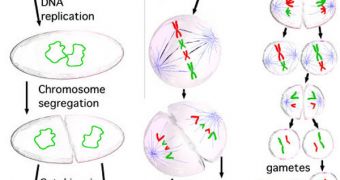In a groundbreaking new study, researchers in the United States managed to discover a trigger mechanism that is involved in controlling the structural integrity of the new cell's nucleus. If the cellular core does not pass the “quality check,” the entire division process is delayed.
The previously-unknown trigger mechanism is a checkpoint that goes into effect right at the very end of cellular division. The reason why it's so important to control the nucleus is because it contains genetic material as DNA.
If the nuclear structure is not correct, the mechanism delays the process until the issues are resolved. Past studies have identified similar checks for DNA division and distribution, but never for a structure such as the nucleus.
Details of the new research were published online in the November 29 issue of The Journal of Cell Biology and online today, November 22, and will also appear in the November 29 online issue of The Journal of Cell Biology.
The investigation was conducted by experts at the University of Utah Huntsman Cancer Institute (HCI). The study identified the protein Aurora B as the main element that delayed cellular division if the nucleus was damaged.
“Much cancer research centers on the question ‘How does cancer start?’ And it’s usually when some normal process that’s vital for cell division is somehow not carried out correctly,” says expert Katharine Ullman, PhD.
She holds joint appointments as a professor in the Department of Oncological Sciences at the university, and as an investigator at the HCI. The scientist is also the senior author of the journal paper, Science Blog reports.
“Mistakes in this stage of quality control and this particular trigger could be one of the contributing factors to the initiation of cancer. It’s not going to be the only one, but it will help us ask additional important questions about how cancer forms,” she explains.
The research team focused its attention on a structure called the nuclear pore complex (NPC), which can be found in the nuclear membrane. The NPC plays a role in mediating the transport of materials from inside the cell to the nucleus and vice-versa.
But new studies appear to suggest that this structure also plays other roles, more notably in cellular division. In this particular study, scientists looked at how NPC operate when they are lacking a compound called Nup153.
“We found that in its absence, a set of architectural elements at, and associated with, the nuclear pore weren’t being put back together correctly during nuclear reformation,” says Ullman.
“At the same time, we saw another protein, Aurora B, stopping the cell cycle from proceeding. The connection we recently found is specific to the last stage of cell division called abscission,” she goes on to say.
“Abscission is the point of no return in the process of one cell becoming two. Although Aurora B needs to be activated and inactivated throughout the cell division process, the impact of the missing Nup153 protein occurred only at this very late stage,” she concludes.

 14 DAY TRIAL //
14 DAY TRIAL //